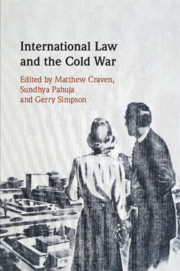Book contents
- International Law and the Cold War
- International Law and the Cold War
- Copyright page
- Dedication
- Contents
- Figures
- About the Editors
- About the Authors
- Acknowledgements
- 1 Reading and Unreading a Historiography of Hiatus
- Part I The Anti-linear Cold War
- Part II The Generative/Productive Cold War
- 4 Accounting for the ENMOD Convention: Cold War Influences on the Origins and Development of the 1976 Convention on Environmental Modification Techniques
- 5 Nuclear Weapons Law and the Cold War and Post–Cold War Worlds: a Story of Co-production
- 6 Parallel Worlds: Cold War Division Space
- 7 Shadowboxing: The Data Shadows of Cold War International Law
- 8 Contesting the Right to Leave in International Law: the Berlin Wall, the Third World Brain Drain and the Politics of Emigration in the 1960s
- 9 Bridging Ideologies: Julian Huxley, Détente, and the Emergence of International Environmental Law
- 10 More than a ‘Parlour Game’: International Law in Australian Public Debate, 1965–1966
- 11 Environmental Justice, the Cold War and US Human Rights Exceptionalism
- 12 The Cold War and Its Impact on Soviet Legal Doctrine
- 13 Forced Labour
- 14 Rupture and Continuity: North–South Struggles over Debt and Economic Co-operation at the End of the Cold War
- 15 The Cold War History of the Landmines Convention
- Part III The Parochial/Plural Cold War
- References to Cold War Volume
- Index
4 - Accounting for the ENMOD Convention: Cold War Influences on the Origins and Development of the 1976 Convention on Environmental Modification Techniques
from Part II - The Generative/Productive Cold War
Published online by Cambridge University Press: 05 December 2019
- International Law and the Cold War
- International Law and the Cold War
- Copyright page
- Dedication
- Contents
- Figures
- About the Editors
- About the Authors
- Acknowledgements
- 1 Reading and Unreading a Historiography of Hiatus
- Part I The Anti-linear Cold War
- Part II The Generative/Productive Cold War
- 4 Accounting for the ENMOD Convention: Cold War Influences on the Origins and Development of the 1976 Convention on Environmental Modification Techniques
- 5 Nuclear Weapons Law and the Cold War and Post–Cold War Worlds: a Story of Co-production
- 6 Parallel Worlds: Cold War Division Space
- 7 Shadowboxing: The Data Shadows of Cold War International Law
- 8 Contesting the Right to Leave in International Law: the Berlin Wall, the Third World Brain Drain and the Politics of Emigration in the 1960s
- 9 Bridging Ideologies: Julian Huxley, Détente, and the Emergence of International Environmental Law
- 10 More than a ‘Parlour Game’: International Law in Australian Public Debate, 1965–1966
- 11 Environmental Justice, the Cold War and US Human Rights Exceptionalism
- 12 The Cold War and Its Impact on Soviet Legal Doctrine
- 13 Forced Labour
- 14 Rupture and Continuity: North–South Struggles over Debt and Economic Co-operation at the End of the Cold War
- 15 The Cold War History of the Landmines Convention
- Part III The Parochial/Plural Cold War
- References to Cold War Volume
- Index
Summary
This chapter is concerned with tracing the history of the drafting of the 1976 Convention on the Prohibition of Military or Any Other Hostile Use of Environmental Modification Techniques (ENMOD). In seeking to understand how and why ENMOD came about, the chapter locates its emergence in the extant superpower rivalry between the USSR and USA around the time of the war in Indochina. Its provisions, it is argued, reflect the complex roles of those powers within the Cold War – as scientific innovators, military superpowers, ideological adversaries and hesitant bilateralists – and survives as a quintessential juridical exemplar of Cold War thought and practice.
Keywords
- Type
- Chapter
- Information
- International Law and the Cold War , pp. 81 - 97Publisher: Cambridge University PressPrint publication year: 2019
- 1
- Cited by

